Face-Recognition Using Raspberry Pi 3
Added on 2023-06-12
42 Pages12328 Words292 Views
Face-Recognition Using
Raspberry Pi 3
Raspberry Pi 3

Abstract
The spot light of this research is on “Face Detection”, where the Raspberry Pi 3 is used for face
detection. The research ensures to explore the history of face-recognization, image recognition
and object detection. With the advanced technology and time security is high in demand and to
help with improvising the security system, the advanced technology has taken inspiration from
God’s creation i.e., the human faces which are unique. This concept of unique faces are
implemented for authentication purpose by swapping with the old systems like, tokens, keys,
plastic cards, smart cards and PINS. The report believes that the uniqueness in the human faces
increases authentication and security, to get access in the restricted areas. The aim of the research
is to detect the presence of faces, if any and introduce the Raspberry Pi 3. Further, various
applications developed and implemented for face recognization are discussed, for instance, in
security and surveillance. Several researchers’ work is reviewed to help the understanding of
face detection. This report reveals the reviewed work on raspberry pi, face recognition,
integration of cloud and IoT. Several reviews of the research papers, help to make the readers
understand the importance of face detection and the improved features of raspberry pi 3. The
other versions of raspberry pi are studied to know the difference and its benefits. The results of
the review represent that high efficiency is guaranteed with the implementation of raspberry pi. It
is also understood that the implementation of raspberry pi has helped to make the framework
cost effective and efficient. Various applications of face recognition are observed in all the
research papers like, security for access of Operating system and databases; for privacy of data
like in medical records; for authentication, for permission based systems; for restricted facilities;
for audit trails; for identification of an individual at the airports; for border controls with
automated identity verification; for home surveillance; for identifying the suspect; for simulated
aging; to reconstruct the faces from the remains of an individual and much more. The advanced
technology plays a vital role in the improvement of face recognition. In-depth study is furnished
about Raspberry pi 3, then its specifications and relation with face recognization. The tool like
OpenCV and python are examined. Subsequently, working of image processing and
implementation on face recognization are researched. The deep learning algorithms are used for
face detection. This research enlightens the readers with the working of these algorithms and
implementation. Therefore, the findings show that, raspberry pi 3 can deliver exceeding benefits,
when implemented in the system.
The spot light of this research is on “Face Detection”, where the Raspberry Pi 3 is used for face
detection. The research ensures to explore the history of face-recognization, image recognition
and object detection. With the advanced technology and time security is high in demand and to
help with improvising the security system, the advanced technology has taken inspiration from
God’s creation i.e., the human faces which are unique. This concept of unique faces are
implemented for authentication purpose by swapping with the old systems like, tokens, keys,
plastic cards, smart cards and PINS. The report believes that the uniqueness in the human faces
increases authentication and security, to get access in the restricted areas. The aim of the research
is to detect the presence of faces, if any and introduce the Raspberry Pi 3. Further, various
applications developed and implemented for face recognization are discussed, for instance, in
security and surveillance. Several researchers’ work is reviewed to help the understanding of
face detection. This report reveals the reviewed work on raspberry pi, face recognition,
integration of cloud and IoT. Several reviews of the research papers, help to make the readers
understand the importance of face detection and the improved features of raspberry pi 3. The
other versions of raspberry pi are studied to know the difference and its benefits. The results of
the review represent that high efficiency is guaranteed with the implementation of raspberry pi. It
is also understood that the implementation of raspberry pi has helped to make the framework
cost effective and efficient. Various applications of face recognition are observed in all the
research papers like, security for access of Operating system and databases; for privacy of data
like in medical records; for authentication, for permission based systems; for restricted facilities;
for audit trails; for identification of an individual at the airports; for border controls with
automated identity verification; for home surveillance; for identifying the suspect; for simulated
aging; to reconstruct the faces from the remains of an individual and much more. The advanced
technology plays a vital role in the improvement of face recognition. In-depth study is furnished
about Raspberry pi 3, then its specifications and relation with face recognization. The tool like
OpenCV and python are examined. Subsequently, working of image processing and
implementation on face recognization are researched. The deep learning algorithms are used for
face detection. This research enlightens the readers with the working of these algorithms and
implementation. Therefore, the findings show that, raspberry pi 3 can deliver exceeding benefits,
when implemented in the system.
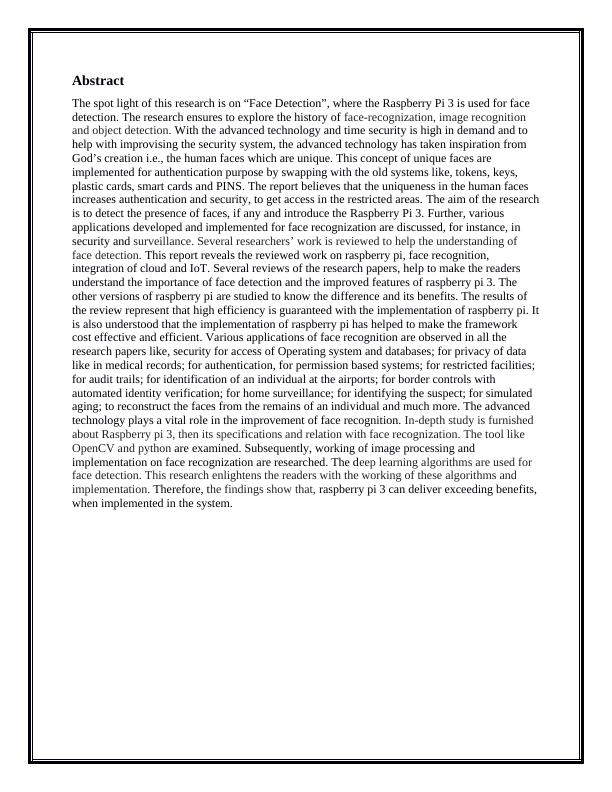
Table of Contents
1. Introduction.............................................................................................................................................................. 1
1.1 Aim..................................................................................................................................................................... 4
1.2 Objective............................................................................................................................................................. 4
1.3 Background........................................................................................................................................................ 5
1.3.1 History of Face-Recognization, Image Recognition and Object Detection....................................................5
1.3.2 Applications for Face Recognization...........................................................................................................6
1.4 Overview of Dissertation..................................................................................................................................... 6
2. Literature Review..................................................................................................................................................... 7
2.1 Overview............................................................................................................................................................. 7
2.2 Summary.......................................................................................................................................................... 11
3. All about Raspberry Pi 3......................................................................................................................................... 11
3.1 Raspberry Pi 3.................................................................................................................................................. 12
3.2 Specification of Raspberry Pi 3.......................................................................................................................... 13
3.3 Comparison of Raspberry Pi Models.................................................................................................................14
3.4 Relation of Raspberry Pi 3 with Face Recognization..........................................................................................21
3.5 Tools: OpenCV Library and Python Programming Language...........................................................................21
3.6 OpenCV Library and its Working with Image Processing.................................................................................21
3.7 Summary.......................................................................................................................................................... 22
4. Methodology........................................................................................................................................................... 23
4.1 Methods............................................................................................................................................................ 23
4.2 Deep Learning Algorithms for Face Detection...................................................................................................25
4.3 Library OpenCV............................................................................................................................................... 26
4.4 Summary.......................................................................................................................................................... 27
5. Conclusion.............................................................................................................................................................. 28
References- 37 more....................................................................................................................................................... 30
1. Introduction.............................................................................................................................................................. 1
1.1 Aim..................................................................................................................................................................... 4
1.2 Objective............................................................................................................................................................. 4
1.3 Background........................................................................................................................................................ 5
1.3.1 History of Face-Recognization, Image Recognition and Object Detection....................................................5
1.3.2 Applications for Face Recognization...........................................................................................................6
1.4 Overview of Dissertation..................................................................................................................................... 6
2. Literature Review..................................................................................................................................................... 7
2.1 Overview............................................................................................................................................................. 7
2.2 Summary.......................................................................................................................................................... 11
3. All about Raspberry Pi 3......................................................................................................................................... 11
3.1 Raspberry Pi 3.................................................................................................................................................. 12
3.2 Specification of Raspberry Pi 3.......................................................................................................................... 13
3.3 Comparison of Raspberry Pi Models.................................................................................................................14
3.4 Relation of Raspberry Pi 3 with Face Recognization..........................................................................................21
3.5 Tools: OpenCV Library and Python Programming Language...........................................................................21
3.6 OpenCV Library and its Working with Image Processing.................................................................................21
3.7 Summary.......................................................................................................................................................... 22
4. Methodology........................................................................................................................................................... 23
4.1 Methods............................................................................................................................................................ 23
4.2 Deep Learning Algorithms for Face Detection...................................................................................................25
4.3 Library OpenCV............................................................................................................................................... 26
4.4 Summary.......................................................................................................................................................... 27
5. Conclusion.............................................................................................................................................................. 28
References- 37 more....................................................................................................................................................... 30

1. Introduction
Today the technology has advanced and so have the applications and perspectives of
seeing things. There is increased need for security and to help with security, the advanced
technology is inspired by God’s creation which is unique in its own terms. Let’s come to the
point now, the human faces are unique and this concept of unique faces are implemented for
authentication purpose instead of, the tokens, keys, plastic cards, smart cards and PINS.
Uniqueness of the faces of each individual is expected to increase the authentication and
security, for getting access in the restricted areas. This unique concept falls under Biometrics.
Biometrics came in to picture due to the serious concerns related to proving an
individual’s identity and authenticity. This technique was used in early days by the emperors for
authenticating the seals using fingerprints and later William James Herschel, who was a British
officer rediscovered biometrics. Today, the use of biometrics is increasing drastically, especially
for in the field of identity documents. However, biometrics is combined with the other types of
security technologies for instance the smart cards.
Biometrics is used for authentication purpose, where an individual is identified and
authenticated depending on a set of recognizable and verifiable data that are unique from others.
The authentication of Biometric, carries out a process, where certain data of an individual like an
individual’s characteristic are compared to that individual's biometric "template" for determining
the resemblance. For identifying the identity of an individual, the purpose of biometric
identification includes to capture an item of biometric data from the individual, which could be
anything like the photo of an individual’s face, image of the person’s fingerprint or the person’s
recorded voice. All these data are used for comparing with the biometric data of various
individuals, from the database.
The below image shows how an individual’s identity is verified.
1
Today the technology has advanced and so have the applications and perspectives of
seeing things. There is increased need for security and to help with security, the advanced
technology is inspired by God’s creation which is unique in its own terms. Let’s come to the
point now, the human faces are unique and this concept of unique faces are implemented for
authentication purpose instead of, the tokens, keys, plastic cards, smart cards and PINS.
Uniqueness of the faces of each individual is expected to increase the authentication and
security, for getting access in the restricted areas. This unique concept falls under Biometrics.
Biometrics came in to picture due to the serious concerns related to proving an
individual’s identity and authenticity. This technique was used in early days by the emperors for
authenticating the seals using fingerprints and later William James Herschel, who was a British
officer rediscovered biometrics. Today, the use of biometrics is increasing drastically, especially
for in the field of identity documents. However, biometrics is combined with the other types of
security technologies for instance the smart cards.
Biometrics is used for authentication purpose, where an individual is identified and
authenticated depending on a set of recognizable and verifiable data that are unique from others.
The authentication of Biometric, carries out a process, where certain data of an individual like an
individual’s characteristic are compared to that individual's biometric "template" for determining
the resemblance. For identifying the identity of an individual, the purpose of biometric
identification includes to capture an item of biometric data from the individual, which could be
anything like the photo of an individual’s face, image of the person’s fingerprint or the person’s
recorded voice. All these data are used for comparing with the biometric data of various
individuals, from the database.
The below image shows how an individual’s identity is verified.
1

Figure: Fingerprints and face recognition of an individual being identified or checking for match
(Gemalto.com, 2018)
The definition of Biometry signifies "measurement of life". It is a quantitative study on the living
beings, which covers a large number of applications, along with medicine and anthropology.
Biometrics is also termed as the processes that are used for recognizing, authenticating and
identifying an individual depending on specific physical or behavioral characteristics.
Thus, biometrics is mainly helpful for identifying an individual and to authenticate the
identity of an individual, using specific characteristics. In Biometrics, the general characteristics
used includes, universal, unique, invariable, recordable and measurable. The universal
characteristics is included so that everyone can use it; then uniqueness is included so that each
individual can be clearly differentiated; the invariable characteristics are included for ensuring
that this concept can be applicable throughout the life of an individual; the characteristics
comprises of recordable characteristics for collecting and storing as data; and the measurable
characteristics is included for ensuring the feature of comparison to determine the results.
The below figure provides the details on each of the biometric characteristics.
Figure: Characteristics of biometrics (IDEMIA, 2018)
2
(Gemalto.com, 2018)
The definition of Biometry signifies "measurement of life". It is a quantitative study on the living
beings, which covers a large number of applications, along with medicine and anthropology.
Biometrics is also termed as the processes that are used for recognizing, authenticating and
identifying an individual depending on specific physical or behavioral characteristics.
Thus, biometrics is mainly helpful for identifying an individual and to authenticate the
identity of an individual, using specific characteristics. In Biometrics, the general characteristics
used includes, universal, unique, invariable, recordable and measurable. The universal
characteristics is included so that everyone can use it; then uniqueness is included so that each
individual can be clearly differentiated; the invariable characteristics are included for ensuring
that this concept can be applicable throughout the life of an individual; the characteristics
comprises of recordable characteristics for collecting and storing as data; and the measurable
characteristics is included for ensuring the feature of comparison to determine the results.
The below figure provides the details on each of the biometric characteristics.
Figure: Characteristics of biometrics (IDEMIA, 2018)
2
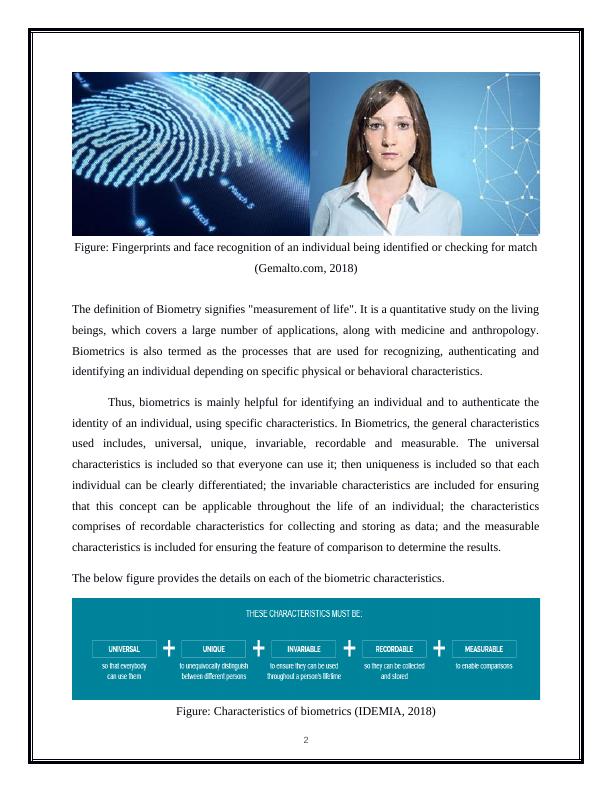
Figure: Types of Biometrics (IDEMIA, 2018)
Biometrics is categorized into biological, morphological and behavioral characteristics.
The biological characteristics refer to DNA, saliva, blood and urine. The morphological
characteristics refer to, hand shape, face, fingerprint, palms, ear, iris, voice, and patterns of the
vein. The behavioral characteristics refer to, walking, handwritten signature of a person and the
stroke of the keyboard. The signature is evaluated based on the pen’s speed while signing, its
pressure and inclination. It is observed that at times the human behavioral traits might change
due to their bad health condition, hunger, fear and so on.
Figure: Biometrics (Gemalto.com, 2018)
3
Biometrics is categorized into biological, morphological and behavioral characteristics.
The biological characteristics refer to DNA, saliva, blood and urine. The morphological
characteristics refer to, hand shape, face, fingerprint, palms, ear, iris, voice, and patterns of the
vein. The behavioral characteristics refer to, walking, handwritten signature of a person and the
stroke of the keyboard. The signature is evaluated based on the pen’s speed while signing, its
pressure and inclination. It is observed that at times the human behavioral traits might change
due to their bad health condition, hunger, fear and so on.
Figure: Biometrics (Gemalto.com, 2018)
3
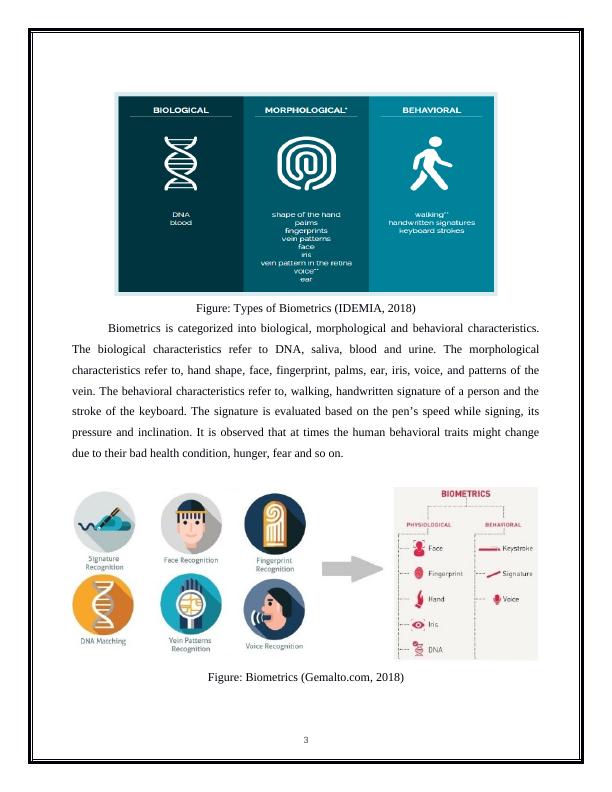
Generally, face detection and recognition system is regarded as highly expensive,
moreover it is simple to understand and contains a non-intrusive process, in contrast to the rest of
the biometrics. The detection of face will be classified as follows:
1) Face detection (1:1)
2) Face recognition (1:N)
The face detection classifies between face versus the non-face area, whereas in the
recognition process, single face image must be compared with multiple images, among the input
image. The process does sound simple but it does contain certain problems, for instance during
the process of capturing images from the web cam, the problems like pose i.e., camera position;
the face might have the objects like spectacles or a beard; expression of the face, image
orientation which might vary in terms of rotation; occlusion which is obstructed by some other
person; imaging condition such as lightning, then camera characteristics and so on. The digital
cameras already contain the Face detection feature. To support the security system, automatic
face detection and recognition systems are placed in some places like the airports.
The Raspberry Pi 3 is an assembled printed circuit board, which don’t contain either a
power supply or an operating system. The model of Raspberry Pi 3 B is said to be the updated
version of $35 Raspberry Pi computer. Moreover, raspberry Pi is just referred as a credit card
sized electronic boards, which is present in the PC or laptop, but it comes in small size and it
doesn’t look like the typical machine. However, the cheap form of raspberry pi 3 contains no
case. Therefore, this research ensures to find the importance of raspberry Pi 3 and face detection,
for security and authentication in different fields.
1.1 Aim
The aim of the research is to detect the presence of faces, if any and introduce Raspberry
Pi 3 for the face detection purpose. The clearly understand the concept of face-recognization,
raspberry pi 3, image recognition and object detection.
1.2 Objective
The objective of this research is to research on the various applications developed and
implemented for face recognization, with respect to authentication and security. Extensive study
will be carried out on raspberry pi 3. Further, the specifications and relation of raspberry pi 3
4
moreover it is simple to understand and contains a non-intrusive process, in contrast to the rest of
the biometrics. The detection of face will be classified as follows:
1) Face detection (1:1)
2) Face recognition (1:N)
The face detection classifies between face versus the non-face area, whereas in the
recognition process, single face image must be compared with multiple images, among the input
image. The process does sound simple but it does contain certain problems, for instance during
the process of capturing images from the web cam, the problems like pose i.e., camera position;
the face might have the objects like spectacles or a beard; expression of the face, image
orientation which might vary in terms of rotation; occlusion which is obstructed by some other
person; imaging condition such as lightning, then camera characteristics and so on. The digital
cameras already contain the Face detection feature. To support the security system, automatic
face detection and recognition systems are placed in some places like the airports.
The Raspberry Pi 3 is an assembled printed circuit board, which don’t contain either a
power supply or an operating system. The model of Raspberry Pi 3 B is said to be the updated
version of $35 Raspberry Pi computer. Moreover, raspberry Pi is just referred as a credit card
sized electronic boards, which is present in the PC or laptop, but it comes in small size and it
doesn’t look like the typical machine. However, the cheap form of raspberry pi 3 contains no
case. Therefore, this research ensures to find the importance of raspberry Pi 3 and face detection,
for security and authentication in different fields.
1.1 Aim
The aim of the research is to detect the presence of faces, if any and introduce Raspberry
Pi 3 for the face detection purpose. The clearly understand the concept of face-recognization,
raspberry pi 3, image recognition and object detection.
1.2 Objective
The objective of this research is to research on the various applications developed and
implemented for face recognization, with respect to authentication and security. Extensive study
will be carried out on raspberry pi 3. Further, the specifications and relation of raspberry pi 3
4
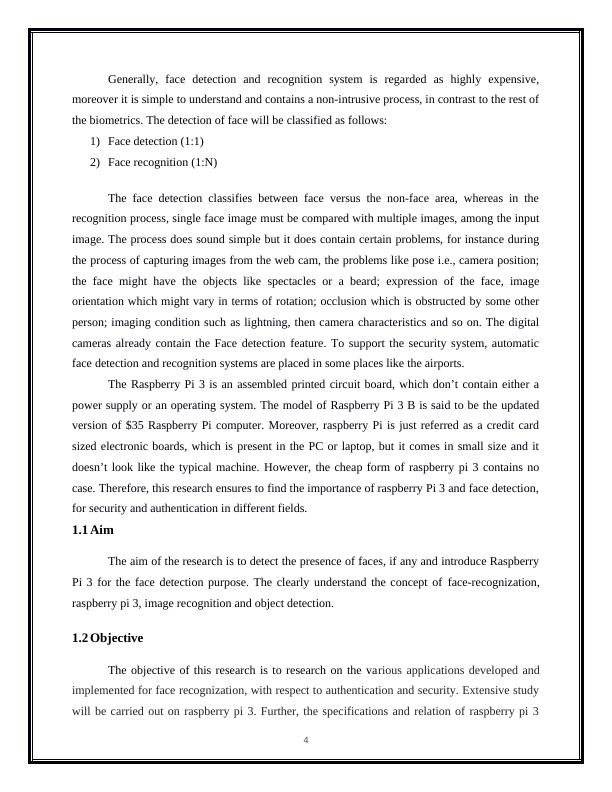
with face recognization will be presented. The tool like OpenCV and python will be examined.
The working of image processing and implementation on face recognization will be researched.
The appropriate algorithms used for face detection will be investigated.
1.3 Background
1.3.1 History of Face-Recognization, Image Recognition and Object Detection
Face Recognization
In image analysis, face recognition is the most relevant application. The technologies
which used face recognition are evolved from years. The very first firm to make investment in
face recognition includes law enforcement agencies. For instance, Woodrow W. Bledsoe case.
The fields like entertainment businesses for products such as Microsoft’s Project Natal; then in
automotive industry and so on. The face recognization was applied in the areas like Information
Security, access management, Biometrics, Personal security and Entertainment (Fin de Carrera,
2010).
Image Recognition (IR)
The Image Recognition had evolved in 2001, where Paul Viola along with Michael Jones
first developed the algorithm for simultaneous face detection that permits to identify the human
figures using the facial traits. Then during 2005, Navneet Dalal along with Bill Triggs published
HOG, which stands for Histograms of Oriented Gradients. This theory featured the detector to
recognize the pedestrians present in the circuits of security system. Again in the year 2012, Alex
Krizhevsky, Ilya Sutskever along with Geoffrey Hinton developed a new algorithm for object
recognition which guaranteed eighty five percent accuracy level. Next in 2015, IR tools were
developed by Convolutional Neural Network (CNN), where the facial recognition’s accuracy
level crossed 95 percent. And today, amazon, car manufacturers and google are in the process of
developing new technologies which could be integrated with Image Recognition. Today, due to
the methodologies, algorithms and its implementation, it is easy to recognize the colors, shapes
along with the moving objects. Various tools are available which makes it easy to classify and
identify the objects (Project ARM, 2018).
Object Detection
5
The working of image processing and implementation on face recognization will be researched.
The appropriate algorithms used for face detection will be investigated.
1.3 Background
1.3.1 History of Face-Recognization, Image Recognition and Object Detection
Face Recognization
In image analysis, face recognition is the most relevant application. The technologies
which used face recognition are evolved from years. The very first firm to make investment in
face recognition includes law enforcement agencies. For instance, Woodrow W. Bledsoe case.
The fields like entertainment businesses for products such as Microsoft’s Project Natal; then in
automotive industry and so on. The face recognization was applied in the areas like Information
Security, access management, Biometrics, Personal security and Entertainment (Fin de Carrera,
2010).
Image Recognition (IR)
The Image Recognition had evolved in 2001, where Paul Viola along with Michael Jones
first developed the algorithm for simultaneous face detection that permits to identify the human
figures using the facial traits. Then during 2005, Navneet Dalal along with Bill Triggs published
HOG, which stands for Histograms of Oriented Gradients. This theory featured the detector to
recognize the pedestrians present in the circuits of security system. Again in the year 2012, Alex
Krizhevsky, Ilya Sutskever along with Geoffrey Hinton developed a new algorithm for object
recognition which guaranteed eighty five percent accuracy level. Next in 2015, IR tools were
developed by Convolutional Neural Network (CNN), where the facial recognition’s accuracy
level crossed 95 percent. And today, amazon, car manufacturers and google are in the process of
developing new technologies which could be integrated with Image Recognition. Today, due to
the methodologies, algorithms and its implementation, it is easy to recognize the colors, shapes
along with the moving objects. Various tools are available which makes it easy to classify and
identify the objects (Project ARM, 2018).
Object Detection
5
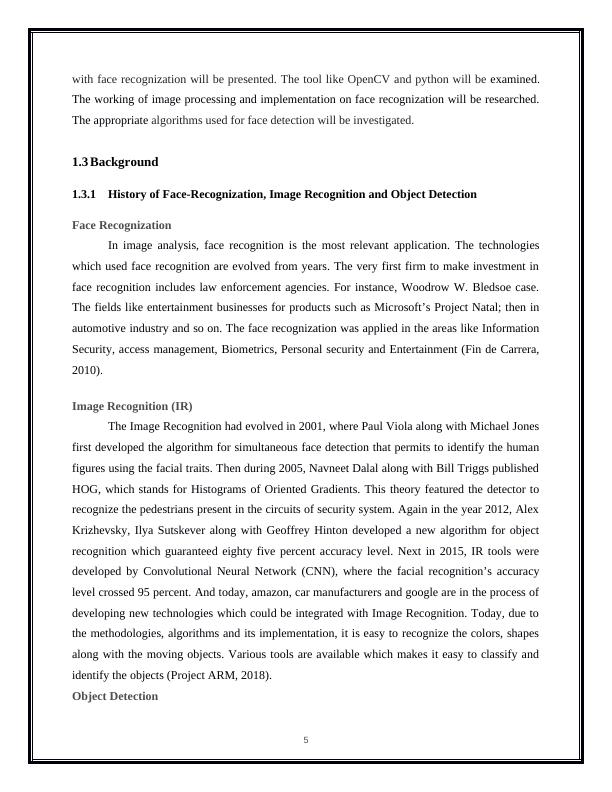
End of preview
Want to access all the pages? Upload your documents or become a member.
Related Documents
Multiple Face Recognition Systemslg...
|9
|2252
|58
Automated Facial Recognition Authenticationlg...
|11
|2729
|126
Biometric Systems | Facial Recognition Deviceslg...
|4
|734
|17
A critique report on a developed face recognition algorithm 2022lg...
|9
|3515
|11
Biometric Security: Implementation, Investigation, and Types of Deviceslg...
|21
|878
|114
Cloud Privacy and Security Introductionlg...
|14
|3560
|224
